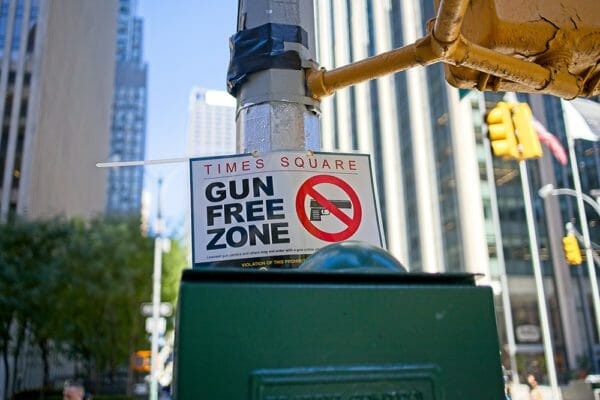
WASHINGTON, D.C. -(Ammoland.com)- Gun Owners of America (GOA) has responded to New York State’s brief to the Supreme Court (SCOTUS).
After the landmark Bruen decision gutted New York State’s “may issue” provision in its concealed carry law, Governor Hochul quickly called a special session of the Empire State’s legislature. The lawmakers passed a new anti-gun law in response to the brilliantly written opinion that Supreme Court Justice Clarence Thomas pinned. The law was called the Concealed Carry Improvement Act (CCIA), and it was one of the most extreme anti-gun laws ever passed in the country.
Most of the State became a gun-free zone in September when the new law was enacted.
GOA teamed up with Ukraine emigrant Ivan Antonyuk to sue New York. That case, Antonyuk v. Bruen (Antonyuk I), was dismissed because Mr. Antonyuk said he would not break the law. GOA filed a new lawsuit with several plaintiffs willing to vow to break the law. The case, Antonyuk v. Hochul (Antonyuk II), saw a Western New York District Federal judge issue a temporary restraining order (TRO) against the CCIA. New York immediately appealed to the Second Circuit Court of Appeals for an emergency stay against the TRO. The Second Circuit is known for being anti-gun and granted the State’s request.
Before the appeals court could rule on if the stay would be made permanent, District Judge Glenn Suddaby issued a temporary injunction against the CCIA. Once again, New York returned to the Second Circuit and asked it to give it another emergency stay against the injunction until the court could hear an appeal. GOA decided the State was playing games with people’s rights. The lawyers for the plaintiffs petitioned Supreme Court Justice Sonia Sotomayor to step in and vacate the stay.
Justice Sotomayor oversees the Second Circuit Court of Appeals and could have turned down the petition, but she granted the petition. If she had turned down the petition, then GOA’s attorneys could have petitioned any Justice who could then vacate the stay with a simple stroke of a pen. She gave New York one week to respond, which New York State did on Tuesday, just under the 4 PM deadline. GOA responded to the State’s brief yesterday morning.
In New York’s brief, the State claimed that the CCIA was passed to bring concealed carry laws in compliance with Bruen. The GOA filing rejected the idea the State was trying to come into compliance with the law. The attorneys for GOA used Governor Hochul’s words against her.
After the Bruen decision, Governor Hochul vowed not to “cede” to SCOTUS’s authority and stated publicly would fight back. Days later, New York would pass the CCIA.
New York then tried to claim that the SCOTUS is unlikely to review the outcome of the case’s appeal because of interlocutory posture. Interlocutory posture is when one part of the case is appealed, but the case is still being argued. GOA claims that the case’s interlocutory posture is irrelevant to the Court’s decision. GOA points out that the State’s appeal to the Second Circuit led New York to its interlocutory posture. New York also claimed that it is unreasonable to believe five members of the Supreme Court would agree with Judge Suddaby. GOA strongly disagrees with the State’s claim.
The plaintiff’s response reads: “In this case, due to the sweeping and ‘patently unconstitutional’ nature of the CCIA (App.184a), and the district court’s careful application of the Bruen framework to the statute, it is hardly ‘unreasonable to believe that five Members of the Court may agree with the decision of the District Court.'”
New York also tried to argue that SCOTUS would be unlikely to review the case because it would “require substantial development in the lower courts, in accordance with traditional patterns of constitutional litigation.” This argument is something GOA’s lawyers attacked on several different levels. First, the GOA attorneys state that the Bruen case is a reaffirmation of the Heller and MacDonald decisions.
The brief reads: “Bruen merely reaffirmed what the Court had already decided more than a decade ago in District of Columbia v. Heller, 554 U.S. 570 (2008) and McDonald, repudiating the two-step ‘judge-empowering ‘interest-balancing inquiry’ that the lower courts had widely adopted.”
The attorneys also point out that the State is simply wrong. It references a case where the court found that warrantless GPS tracking of vehicles by police violated the Fifth Amendment. Another case was heard immediately about police using a drug-sniffing dog on a suspect’s porch without a warrant. SCOTUS ruled on both of those cases back-to-back.
New York State also argued that the stay preserved the “status quo,” but the plaintiffs’ lawyers disagreed, pointing out that the law just went into effect in September. Not all provisions have been fully implemented. GOA argues that the “status quo” was before the CCIA was enacted, so the injunction is preserving the “status quo.”
The plaintiffs also claim that the State did not undermine their likelihood of success. They claim that the Second Circuit applied the wrong standard at the urging of the State. The Second Circuit did not give any reasoned argument as to why it decided to stay the District Court’s ruling. The lawyers state that claiming that they must provide a robust legal challenge to a single sentence is absurd. They contend that the Second Circuit erred by not providing a reasoned analysis based on evidence. The lawyers for GOA pointed out that New York didn’t point out any flaws in the District Court’s decision. The plaintiff’s attorneys also took issue with New York, claiming it would likely succeed on the case’s merits.
One of the more outlandish things that New York claimed was that many aspects of the CCIA do not implicate the Second Amendment, and therefore the State does not have to provide historical analogs as required under Bruen. GOA’s lawyers point to many places in the CCIA that deal with the Second Amendment. Many see this argument as a “Hail Mary” if all else fails.
One of the more interesting claims that New York State made was that one of the plaintiffs didn’t have standing to challenge the licensing scheme since the plaintiff didn’t have a permit. The lawyers for the plaintiff pointed out that he has been trying to get a permit for a year, but due to New York stalling on the appointments, he has not been able to complete his application.
New York’s final argument is that “a stay was necessary to prevent regulatory chaos and public confusion….”
The State cites Citibank, N.A. v. Nyland. GOA’s lawyer objects to the comparison. They point out that Nyland is about the rental market. They point to the fact New York “bears responsibility for having ‘to explain’ a statute that it has enacted, and which the district court called ‘patently unconstitutional.'”
SCOTUS doesn’t have a timeline to rule on the stay, but it will probably be sooner than later.
About John Crump
John is a NRA instructor and a constitutional activist. John has written about firearms, interviewed people of all walks of life, and on the Constitution. John lives in Northern Virginia with his wife and sons and can be followed on Twitter at @crumpyss, or at www.crumpy.com.

from https://ift.tt/jKl0TMq
via IFTTT

No comments:
Post a Comment